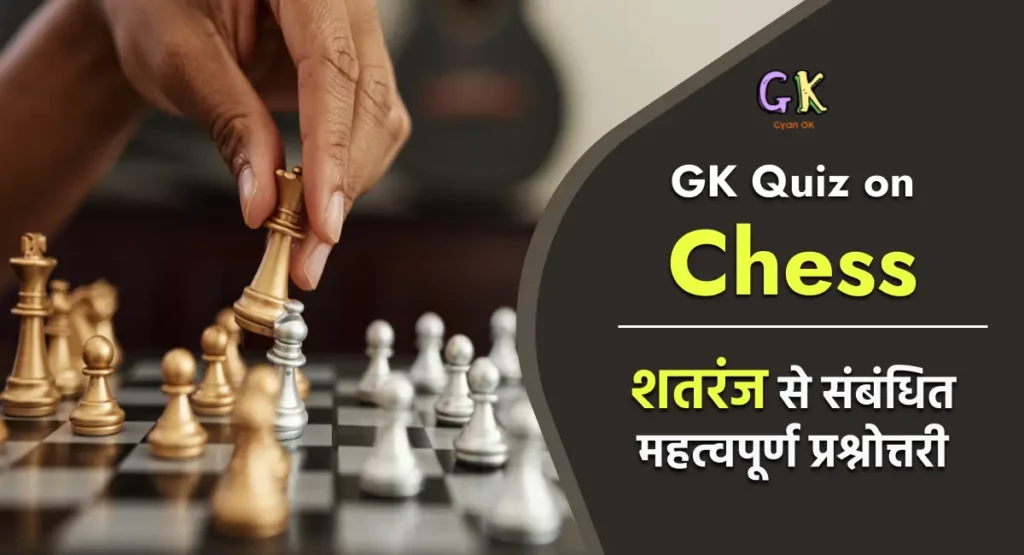Chess, a captivating game, is not only fun but also good for the brain. It helps you think better, plan, and make smart choices. Chess also teaches patience and helps you focus. It’s a game where you learn to play fair and be a good sport. Plus, it’s a great way to exercise your mind and come up with new ideas. So, to make it even more interesting, we’ve made a quiz about chess in the following article.

General Knowledge Quiz on Chess
Chess is a classic two-player strategy board game where the objective is to checkmate your opponent’s king while protecting your own. It’s played on an 8×8 grid with various pieces like kings, queens, rooks, knights, bishops, and pawns, each with unique movement rules. Chess is a game of skill, tactics, and foresight, requiring players to plan their moves ahead and anticipate their opponent’s actions. It’s a game that challenges the mind and fosters critical thinking, making it a timeless and intellectually rewarding pastime.
Below we have prepared a quiz on the topic of chess to help you gain some additional insights and to self-assess yourself too.
[–MCQ-QUESTIONS-DISPLAY–]
Origin of Chess
The origins of chess are shrouded in the mists of time, with its roots tracing back to ancient India. Around the 6th century AD, a precursor of chess, known as “Chaturanga,” emerged as a strategic board game in the Indian subcontinent. Chaturanga represented four divisions of the military: infantry, cavalry, elephants, and chariotry, each denoted by pieces resembling the modern pawn, knight, bishop, and rook, respectively. The game’s objective was to checkmate the opponent’s king, mirroring the essence of contemporary chess.
Over centuries, Chaturanga evolved, with rules adapting and expanding. As it journeyed westward, through Persia (modern-day Iran), it transformed into “Shatranj,” gaining features like the powerful queen, which replaced the counselor piece, and refined rules regarding piece movements and board setup.
In the 7th century, chess entered the Islamic world, where it thrived as a strategic pastime, and scholars wrote treatises on its tactics and strategies. From there, it spread across medieval Europe, experiencing further adaptations in piece names, rules, and strategies.
By the 15th century, chess as we know it today had taken shape, with the modern queen and bishop introduced in Europe, and the rules standardized. It transcended borders, languages, and cultures, becoming a revered global pastime and an emblem of strategy and intellectual prowess. Chess’s journey from ancient India to the world stage is a testament to its enduring appeal and the universal language of strategy it speaks.
How to Play Chess?
Chess is a classic board game that has captivated minds for centuries with its intricate strategies and intellectual challenges. Whether you’re new to the game or looking to improve your skills, this beginner’s guide will walk you through the basics of how to play chess.
Setting Up the Chessboard:
- The Chessboard: Start with an 8×8 square board, alternating between 64 dark and light squares. Place the board between you and your opponent so that each player has a light square on their right-hand corner.
- Chess Pieces: Each player has 16 pieces:
- King (1): The most crucial piece. Protect it at all costs.
- Queen (1): A powerful piece with long-range movement.
- Rooks (2): These move horizontally and vertically.
- Knights (2): Knights move in an L-shape: two squares in one direction, then one square perpendicular to that.
- Bishops (2): These move diagonally.
- Pawns (8): Pawns move forward one square but capture diagonally.
- Piece Placement: Arrange your pieces on the two rows closest to you. The back row should have the following pieces (from left to right): Rook, Knight, Bishop, Queen (with the Queen on her own color), King, Bishop, Knight, Rook. The front row should have all the pawns.
Objective:
The main objective in chess is to checkmate your opponent’s king. This means putting the opponent’s king into a position where it is under attack and cannot escape capture.
How the Pieces Move:
- King: The king moves one square in any direction – horizontally, vertically, or diagonally.
- Queen: The queen can move any number of squares in any direction – horizontally, vertically, or diagonally.
- Rook: Rooks move horizontally or vertically any number of squares.
- Knight: Knights move in an L-shape: two squares in one direction (either horizontally or vertically), then one square perpendicular to that. Knights are the only pieces that can “jump” over other pieces.
- Bishop: Bishops move diagonally any number of squares.
- Pawn: Pawns move forward one square but capture diagonally. On their first move, pawns have the option to move forward two squares.
Special Moves and Rules:
- Castling: This move involves the king and one of the rooks. It is the only time two pieces move in a single turn. Castling is done to safeguard the king. The king moves two squares towards a rook on its original square, then that rook is placed on the square the king skipped over.
- En Passant: If a pawn moves two squares forward from its starting position and lands beside an opponent’s pawn, the opponent has the option to capture the moving pawn as if it had only moved one square forward.
- Pawn Promotion: When a pawn reaches the opponent’s back rank (eighth rank for White, first rank for Black), it can be promoted to any other piece (except a king). Most often, players choose a queen as the promotion.
- Check and Checkmate: When a king is under attack, it’s in check. The player must make a move that removes the king from check. If there’s no legal move to get the king out of check, it’s checkmate, and the game ends.
Basic Strategies:
- Control the Center: Occupying the center of the board with your pieces can give you more control and flexibility.
- Development: Bring out your knights and bishops early to control the board and prepare for castling.
- King Safety: Keep your king safe. Castling can help tuck your king behind a wall of pawns.
- Pawn Structure: Be mindful of pawn moves, as they can’t move backwards. Don’t create weaknesses in your pawn structure.
- Piece Exchanges: Think about whether exchanging pieces is beneficial for your position.
- Tactics and Patterns: Familiarize yourself with common tactics like forks, pins, skewers, and discovered attacks.
- Endgame Skills: As the game progresses and fewer pieces are on the board, understanding endgame principles becomes crucial. King activity and pawn promotion become vital.
Remember, chess is a game of practice and learning from your mistakes. The more you play and study, the better you’ll become. So, get out there, set up the board, and start enjoying the world of chess!





